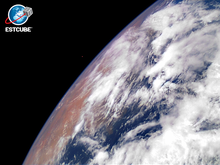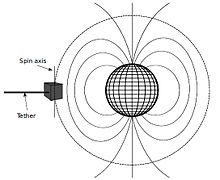


ESTCube-1 illustration
| |
| Mission type | Technology |
|---|---|
| Operator | University of Tartu |
| COSPAR ID | 2013-021C |
| SATCAT no. | 39161 |
| Website | http://www.estcube.eu/en/home |
| Mission duration | 12 months |
| Spacecraft properties | |
| Launch mass | 1.048 kilograms (2.31 lb) |
| Dry mass | 1.048 kilograms (2.31 lb) |
| Power | 3.6W [1] |
| Start of mission | |
| Launch date | 7 May 2013, 02:06:31 (2013-05-07UTC02:06:31Z) UTC |
| Rocket | Vega |
| Launch site | Kourou ELA-1 |
| Contractor | ESA |
| End of mission | |
| Deactivated | 17 Feb 2015, 10:27:00 (2015-02-17UTC10:27Z) UTC[2] |
| Last contact | 19 May 2015[1] |
| Decay date | 2038*estimated |
| Orbital parameters | |
| Reference system | Geocentric |
| Regime | Low Earth |
| Perigee altitude | 665 km |
| Apogee altitude | 665 km |
| Inclination | 98.129 degrees |
| Period | 98.03 minutes |
ESTCube-1 is the first Estonian satellite and first satellite in the world to attempt to use an electric solar wind sail (E-sail). It was launched on 7 May 2013 aboard a Vega carrier rocket[3][4] and successfully deployed into orbit.[5] The CubeSat standard for nanosatellites was followed during the engineering of ESTCube-1, resulting in a 10x10x11.35 cm cube, with a volume of 1 liter and a mass of 1.048 kg.[6][7]
The mission ended in 17 February 2015 and it was said that during this time it resulted 29 bachelor's and 19 master's dissertations, 5 doctoral theses and 4 start-ups.[8]




Developed as part of the Estonian Student Satellite Program, an educational project in which university and high school students can participate.[9][10]
While emphasis was placed on educating students during creation of ESTCube-1, it does have a scientific purpose. On board the satellite is an electric solar wind sail (E-sail) which was invented by Finnish scientist Pekka Janhunen. During the ESTCube-1 flight, 10 meters of 20–50 micrometer thick E-sail wire, sometimes referred to as "Heytether," were to be deployed from the satellite. The deployment of the Heytether was to be detected by a decrease of the satellite's rotation speed or an onboard camera.[11]
To control the E-sail element's interaction with both the plasma surrounding the Earth and the effect it has on the spacecraft's spinning speed, two nanotechnology electron emitters/guns are on board. The electron emitters are connected to the E-sail element which were to be charged positively to 500 volts by shooting out electrons. The positive ions in the plasma were intended to push the E-sail element and influence the satellite's rotation speed. The effect of the plasma on the E-sail was to be measured by the change in said rotation speed. The tether was also intended to de-orbit the satellite by use as a plasma-brake to demonstrate a possibility for returning small satellites from orbit. A color CMOS camera is also on board that is capable of making RAW-format pictures with VGA-resolution. This camera is used to acquire images of Earth and to monitor deployment of the Heytether.
To complete the scientific experiment and communicate with the satellite on several occasions the orbit chosen was a sun–synchronous circular orbit at an altitude of 670 kilometers. ESTCube-1 was launched into orbit by Arianespace, using a Vega rocket which lifted off from ELA-1atKourou at 02:06:31 UTC on 7 May 2013. The satellite was placed into orbit and communication successfully established,[12] with the first photo of the Earth taken on May 15 and transmitted to the ground on the amateur radio band.[5]
The plan, beginning with the 7 May 2013 launch, included the following steps:
The mission ended due to degradation of the photovoltaic power system[1] and subsequently the batteries became exhausted. The last morse code transmission was transmitted on 17 February 2015. The plan to test a solar sail the satellite carried failed since the sail cable unwinding mechanics did not survive the rocket takeoff vibration.[13]
During the development of the Estonian satellite mission it was decided to make a 1U CubeSat. By standard 1 unit (1U) CubeSat base side length must be 100.0±0.1 millimeters and satellite height must be 113.5±0.1 mm. Mass is also set in CubeSat standard, the highest possible mass for 1U CubeSat is 1300 grams.
Communication from the satellite is made at two International Amateur Radio Unions registered frequencies
Periodic but very slow communication was made by using 18 WPM telegraphy signal on a frequency of 437.250 MHz. At that frequency, the most important satellite parameters are returned every 3 to 10 minutes. For fast connections FSK-modulation radio signals on a frequency of 437.505 MHz with a 9600 baud connection speed and AX.25 packet standard is used. The relatively slow connection speeds result from the use of amateur radio frequencies which limits the bandwidth to 25 kilohertz. The fast connection is used only when the satellite has been given a specific order. Both telegraphy and packet telemetry protocols of ESTCube-1 are published on project webpage.[15][16]
Commands sent to the satellite used the 145 MHz (2 meter) amateur band.
ESTCube-1 microcontrollers use the following operating systems:
Mission Control System is currently being developed by the students of Tartu University under the supervision of the company CGI Group.

ESTCube-1 was launched as a secondary payload on the Vega rocket,[4] the least expensive satellite launch offered by the European Space Agency. Because Estonia is an associated member of ESA, most of the launch expenses (about 70,000 euros) were covered by the Estonian member fee for educational expenses. With the launch, total expenses for the project were approximately 100,000 euros.
This section needs expansion with: text. You can help by adding to it. (May 2015)
|
The satellite successfully demonstrated the operation of the systems in space, with a two-year operational life. The deployment of the E-sail was unsuccessful, and no measurements were taken of the E-sail or of the plasma braking deployment system.
{{cite web}}: Unknown parameter |deadurl= ignored (|url-status= suggested) (help)
{{cite web}}: Unknown parameter |deadurl= ignored (|url-status= suggested) (help)
|
| |
|---|---|
| January |
|
| February |
|
| March |
|
| April |
|
| May | Zhongxing 11 |
| June |
|
| July |
|
| August |
|
| September |
|
| October |
|
| November |
|
| December |
|
Launches are separated by dots ( • ), payloads by commas ( , ), multiple names for the same satellite by slashes ( / ). | |